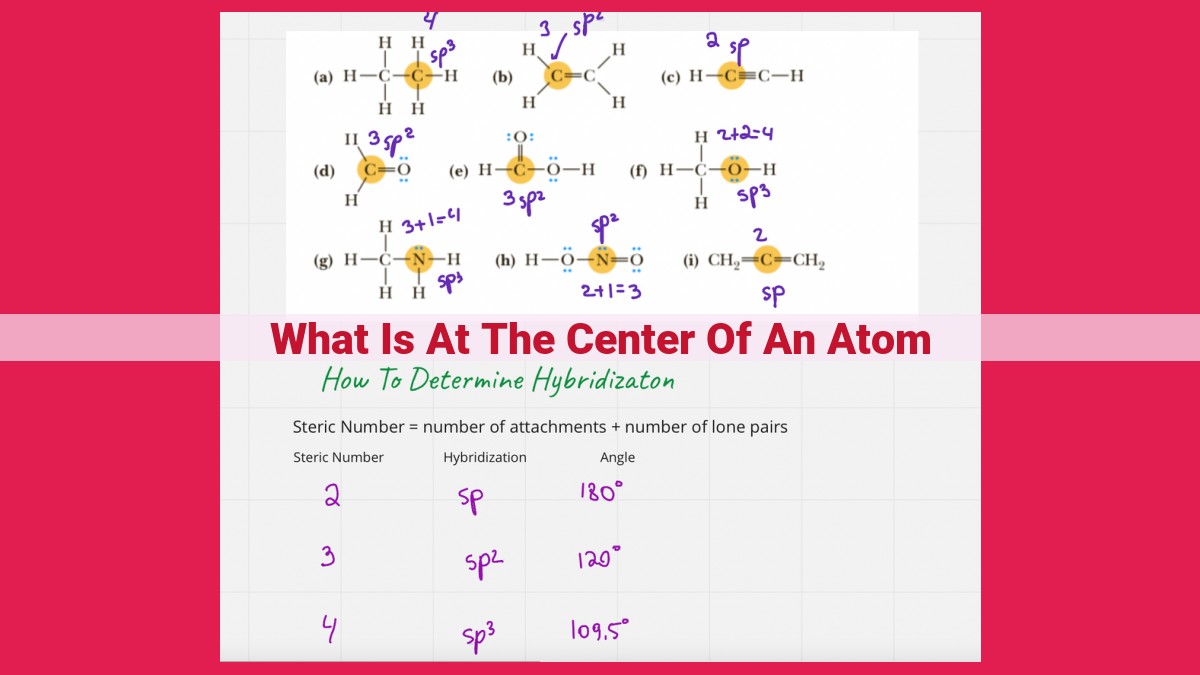Unveiling The Atom: A Journey Into The Core, Nucleus, And Electron Orbitals

At the core of an atom lies the atomic nucleus, a dense hub of mass comprised of positively charged protons and uncharged neutrons. Protons, the defining identity of each element, reside in the nucleus. Neutrons balance the nucleus’s mass. Beyond the nucleus, electrons, negatively charged particles, orbit in invisible electron orbitals, forming the atom’s outer regions.
Deciphering the Heart of an Atom: Delving into the Atomic Nucleus
Introduction:
Every atom, the fundamental building block of matter, harbors a densely packed core known as the atomic nucleus. This microscopic realm holds the lion’s share of the atom’s weight and plays a pivotal role in shaping the chemical world we perceive. Let us embark on a journey to unravel the secrets of the atomic nucleus, starting with its enigmatic inhabitants: protons and neutrons.
The Protons: Guardians of Atomic Identity
Within the nucleus, positively charged protons reside, their presence defining the element to which the atom belongs. The number of protons, aptly termed the atomic number, uniquely identifies each element on the periodic table. These tiny particles not only determine an atom’s chemical properties but also exert a strong influence on its mass.
Neutrons: Companions in Mass
Accompanying the protons in the nucleus, we find neutrons, particles devoid of any electrical charge. Their primary role lies in contributing to the atom’s mass. Neutrons, working alongside protons, play a vital role in stabilizing atomic nuclei and modulating radioactive decay processes.
Protons: The Positively Charged Companions of the Nucleus
At the heart of every atom lies its nucleus, a tiny, dense region that harbors most of the atom’s mass. Within this nuclear realm reside two fundamental particles: protons and neutrons.
Protons: The Positively Charged Pillars
Protons are positively charged particles that dwell within the nucleus. They possess an electric charge equal but opposite to that of electrons. Protons serve as the building blocks of an element’s identity. The number of protons in the nucleus determines the element itself. Each element has a unique atomic number assigned to it, which corresponds to the number of protons it carries.
For instance, all atoms with one proton are hydrogen atoms, those with two protons are helium atoms, and so on. The number of protons remains constant for atoms of the same element, setting them apart from other elements. This defining characteristic is why protons play a crucial role in determining an element’s chemical behavior and properties.
Neutrons: The Neutral Partners in the Nucleus
At the very heart of every atom lies a dense region known as the nucleus, where most of the atom’s mass resides. Within this nucleus dwell two types of particles: protons and neutrons. Protons possess a positive electrical charge, while neutrons carry no charge whatsoever, hence their name.
Neutrons play a crucial role in the stability and identity of atoms. Alongside protons, they reside in the nucleus, contributing to the overall mass of the atom. The number of protons in an atom defines its unique elemental identity, while the number of neutrons determines the particular isotope of that element. Isotopes are atoms of the same element that differ in their neutron count.
In contrast to protons, which impart a positive charge to the nucleus, neutrons remain neutral, balancing out the electrical forces within the atom. This delicate balance between positive and neutral charges ensures the stability of the atomic nucleus. Without neutrons, the positive charges of the protons would repel each other, causing the atom to disintegrate.
Thus, neutrons serve as indispensable partners in the nucleus, providing mass, stability, and contributing to the diverse properties of atoms that make up our world.
Electrons: Orbiting Outside the Nucleus, Shaping the Atom’s Identity
In the captivating realm of atoms, beyond the dense core of the nucleus, a dance of electrons unfolds. These enigmatic particles, adorned with a negative charge, embark on a ceaseless journey around their atomic abode.
Imagine the nucleus as a celestial hub, brimming with protons and neutrons. Protons, like miniature suns, radiate with positive charge, defining each element’s unique identity. Meanwhile, neutrons, their neutral counterparts, lend a stabilizing presence to the atomic core.
Contrasting the dense nucleus, electrons reside in a vast expanse, gracefully tracing paths known as orbitals. These orbitals, envision them as ethereal clouds, envelop the nucleus in layers. Each layer, a testament to the electron’s energy level, dictates its distance from the core.
The electrons’ ceaseless dance weaves an intricate tapestry of electron clouds. These clouds, dynamic and mutable, shroud the nucleus, shaping the atom’s overall identity. As electrons occupy higher energy levels, their clouds expand, influencing the atom’s chemical behavior.
Their proximity to the nucleus, a vital measure of electronegativity, determines how tightly an atom holds onto its electrons. This dance between electrons and the nucleus underlies much of chemistry, guiding the formation of bonds that bind atoms together.
So, as we delve into the microscopic realm, let us marvel at the dance of electrons, the ethereal inhabitants of the atom’s outer realm, whose movements shape the very essence of matter.